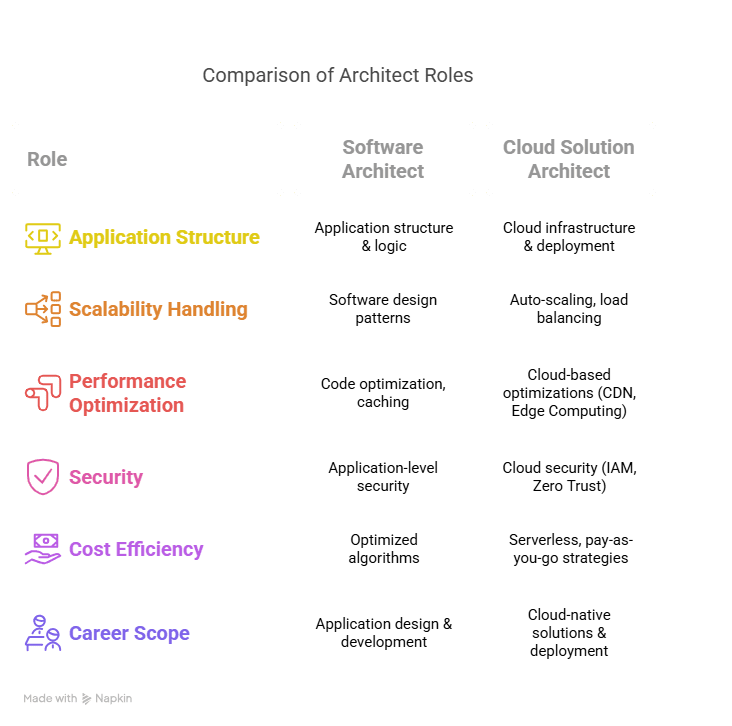Skip to main contentIn today’s cloud-first world, the most effective Cloud Solution Architects are those who also have a deep understanding of Software Architecture. Here’s why mastering both domains is the best-case scenario:
1️⃣ Software Architecture is the Foundation of Cloud-Native Design
Cloud Solution Architects design applications that run on AWS, Azure, or Google Cloud, but these applications still need strong software architecture. Without a solid software foundation, even the most optimized cloud infrastructure will fail in performance, maintainability, or security.
🔹 Example: A Microservices-Based E-commerce Platform
A Software Architect will design the microservices structure—how each service (user authentication, payment, product catalog) interacts.
A Cloud Solution Architect ensures the deployment of these services in a cloud-native environment (e.g., using Kubernetes, AWS Lambda, or Azure Functions).
Without good software architecture, the cloud implementation might suffer from:
Poor modularization (leading to inefficient microservices).
Inefficient API design, causing high latency.
Stateful dependencies, making it hard to scale properly.
✅ Solution: If the Cloud Solution Architect understands Software Architecture, they can align cloud infrastructure with well-architected application design, making deployments more scalable, cost-effective, and efficient.
2️⃣ Cloud Solution Architects Need to Optimize Software for Scalability & Performance
Software Architects design applications independently of the cloud (which can work on-premise, hybrid, or cloud environments).
Cloud Solution Architects must take those designs and optimize them for cloud performance by:
Choosing serverless vs containerized approaches.
Using cloud-based databases (like AWS DynamoDB or Azure Cosmos DB) instead of traditional SQL databases.
Implementing event-driven architectures for better scaling (e.g., using AWS SQS, EventBridge).
🔹 Example: A Video Streaming Platform (Like Netflix)
A Software Architect might design a monolithic or microservices system for video storage, processing, and delivery.
A Cloud Solution Architect ensures:
The system auto-scales to support millions of users.
Content is stored in cloud object storage (S3, Azure Blob) instead of traditional databases.
A Content Delivery Network (CDN) is used to reduce latency.
✅ Solution: If the Cloud Architect lacks Software Architecture skills, they might struggle to integrate the cloud infrastructure with the software’s data processing workflows, leading to performance bottlenecks.
3️⃣ Security & Cost Optimization Require Software Understanding
Cloud-based systems are pay-as-you-go, meaning poorly designed software can result in high cloud costs.
🔹 Example: A SaaS CRM (Customer Relationship Management) Tool
A Software Architect may design the database interactions using REST APIs that call the database frequently.
A Cloud Solution Architect might notice that:
Each API call spins up a new cloud instance, leading to unnecessary costs.
Using GraphQL or caching (Redis, CloudFront) could reduce API calls, lowering cloud costs by 50%.
✅ Solution: If a Cloud Solution Architect understands software design principles, they can align architecture with cloud best practices—making the system faster and more cost-efficient.
4️⃣ Career Advantage: The Future is Cloud-Native Software Engineering
With the rise of AI, DevOps, and cloud-based ML models (MLOps), companies are demanding full-stack Cloud Architects who can:
Design scalable applications (Software Architecture)
Deploy them efficiently on the cloud (Cloud Solution Architecture)
Automate deployment (DevOps, MLOps)
🔹 High-Demand Roles That Require Both Skills
✅ Cloud Solution Architect with Software Architecture Expertise
✅ Cloud-Native Developer (Full-Stack with Cloud Focus)
✅ Enterprise Cloud Architect
✅ AI/ML Solution Architect (Deploying AI Models in Cloud)
✅ DevSecOps Architect (Security + Cloud + Software Design)
Conclusion: Why Being Skilled in Both Matters
